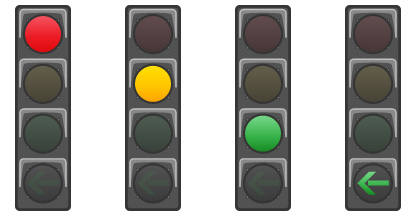Cyclists have the same rights and responsibilities as motorists. For example, cyclists must:
- Yield to pedestrians
- Stop for stop signs
- Signal turns
- Travel with the flow of traffic.
In the eyes of the law, if you are riding a bicycle on the road, you are considered a vehicle on the road.
When you dismount and walk alongside your bicycle, you are considered a pedestrian and have the same rights as a pedestrian.
Roads
 Follow the rules of the road when riding on city streets. Be extra cautious at busy intersections. Look well ahead always scan intersections before crossing.
Follow the rules of the road when riding on city streets. Be extra cautious at busy intersections. Look well ahead always scan intersections before crossing.
Sidewalks
 Cycling on sidewalks may or may not be allowed in your community. Be sure you know the rules. Cyclists exiting private property, a driveway or an alley must yield to all road users.
Even if bikes are permitted, sidewalks present many hazards to cyclists, such as:
Cycling on sidewalks may or may not be allowed in your community. Be sure you know the rules. Cyclists exiting private property, a driveway or an alley must yield to all road users.
Even if bikes are permitted, sidewalks present many hazards to cyclists, such as:
- Pedestrians with pets and strollers
- Sprinkler systems
- Obstructions such as debris, open gates, planters and landscaping
- Other cyclists, skateboarders, walkers and runners.
Crosswalks and Overpasses
 Walk your bike on pedestrian crosswalks and overpasses. This gives you the right-of-way as a pedestrian. If you ride your bike across crosswalks and overpasses, you may not have the legal right-of-way.
Walk your bike on pedestrian crosswalks and overpasses. This gives you the right-of-way as a pedestrian. If you ride your bike across crosswalks and overpasses, you may not have the legal right-of-way.
Trails
 Cycling is permitted on trails designed as bicycle routes. Always obey posted trail and park closures.
Cycling is permitted on trails designed as bicycle routes. Always obey posted trail and park closures.
Parks
 Some parks require cyclists to leave parks by closing time. Check with local police or park rangers.
Some parks require cyclists to leave parks by closing time. Check with local police or park rangers. Cyclists are required to obey the same road signs and traffic signals as motorists. If you allow children to ride in traffic, it’s important they understand all signals and markings they will encounter.
| Sign | Requirement |
|---|---|
| Stop Sign | Come to a full stop. Do not proceed until safe to do so. |
| Yield Sign | Yield right-of-way to traffic not facing the sign and to pedestrians in intersection or crosswalk. |
| Pedestrian Crosswalks | Watch for pedestrians. If Pedestrians are crossing, come to a full stop. |
| One-Way Sign | Travel only in the direction of the arrow. |
Entering the Street from a Driveway or Alley
Cyclists exiting private property, a driveway or an alley must yield to all road users.
- Come to a complete stop.
- Look left, center and to the right.
- Look over your shoulder to ensure there are no other vehicles or cyclists.
- Hand signal your intentions.
- Look well ahead. When clear of vehicles and pedestrians and safe to do so, proceed to the right hand lane of the street.
Right of Way
Cyclists must always yield to pedestrians or other road users already in the intersection or crosswalk.
- As you approach a controlled or uncontrolled intersection, scan left, center and right for pedestrians.
- If there are pedestrians waiting to cross or crossing the street, come to a full stop and yield the right of way to the pedestrian.
- Wait until the pedestrian is clear of the crosswalk.
- Scan left, center and right for any other road users.
- Proceed through the intersection when safe to do so.
Intersections
Cyclists exiting private property, a driveway or an alley must yield to all road users.
- Come to a complete stop.
- Look left. Look right. Look left again.
- Look over your shoulder to ensure there are no other vehicles or cyclists.
- Hand signal your intentions.
- Look well ahead. When clear of vehicles and pedestrians, proceed to the right hand lane of the street.
Scanning
Use this scanning technique prior to turns, lane changes and crossing intersections.
- Look at least one block ahead.
- Keep your eyes constantly scanning for hazards on or beside the road (look for objects such as potholes or debris on the road, scan for any activity in and around parked vehicles.)
- Look left, center, and right prior to crossing intersections.
Traveling Straight
- Ride in a straight line. Look well ahead and continuously scan left, center and right.
- Use the right-hand curb lane (except when it becomes a right-turn only lane) and stay at least three feet from the curb to avoid roadside hazards.
- When cars are parked, ride in a straight line at least three feet away from parked cars to avoid drivers who may open their car doors.
Cyclists tend to travel slower than other vehicles on the road. As a result, remember the following general road rules:
- Slower traffic stays right.
- Slower traffic must give way to faster traffic when safe and practical.
Right Turns
- Scan left, center and right.
- Hand signal your intention to turn right.
- Look over your right shoulder to ensure it is safe to turn and no other road users are beside you.
- If safe to do so, turn into the first available lane and if proceeding straight ahead, stay in the right hand lane.
Left Turns
When an intersection is very busy and it appears unsafe to move to the left turning lane:
- Ride straight through the intersection.
- Dismount from your bicycle at the corner of the intersection and walk the bike across the street as a pedestrian.
- Remount your bicycle.
- Scan left, center and right.
- Check over your shoulder to ensure there are no vehicles behind you.
- Hand signal your intention to pull away from the curb.
- Check over your shoulder again to ensure it is safe to go.
- Proceed on the right hand side of the lane.
When an intersection is not as busy and it appears safe to move into the left turning lane, use the following steps to change into the left hand lane to make the left turn:
- Scan left, center and right.
- Check over your shoulder to ensure there is no traffic behind you.
- Hand signal your intention to turn left.
- Check over your shoulder again to ensure it is safe to go.
- Move and position your bicycle just to the right of the center line.
- Turn left when safe to do so.
- After you have made your turn, check over your shoulder, hand signal, check over your shoulder again and move to the far right-hand lane.
Changing Lanes
The procedure for making a lane change is:
- Check over your shoulder for a gap in traffic to change lanes.
- Hand signal your intention to move left or right.
- Check over your shoulder again to ensure it is still safe to change lanes.
- If safe, steer into the lane and continue your trip.
Intersections
There are two kinds of intersections; controlled and uncontrolled.
Controlled Intersections
Two or more roads come together with some type of traffic control device. These devices may be signs or traffic signal lights.
- Before entering a controlled intersection, scan left, center and right.
- Enter the intersection either ahead of or behind vehicles to ensure that motorists see you.
- Watch or traffic signals and be prepared to stop.
- Remember to keep eye contact with all motorists.
Uncontrolled Intersections
Two or more roads come together with no traffic signs or traffic signal lights.
- Before entering an uncontrolled intersection, scan left, center and right.
- The cyclist/vehicle that arrives first should go first.
- If two or more cyclists/vehicles arrive at the intersection at the same time, the cyclist/vehicle on the left should yield to the cyclist/vehicle on the right.
At an uncontrolled intersection, use caution, be prepared to stop and yield to traffic on your right.
Turning Lanes
Right Turn Only
When approaching an intersection, you may come across a turning lane. If you come across a right-turn only lane and you wish to go straight:
- Scan left, center and right.
- Check over your shoulder for vehicles on your left side and behind you.
- Hand signal your intention to change lanes.
- Check over your shoulder again.
- Move to the adjacent through lane when safe.
Right Turn & Straight Through
If you come across a right-turn lane with an option to continue going straight through the intersection:
- Scan left, center and right.
- Check over your shoulder for vehicles on your left side and behind you.
- Move to the middle of the lane before proceeding.
- Proceed through the interesection when safe to do so.
Large Vehicles
Be cautious when riding alongside large vehicles such as trucks, buses, vans, SUVs or motor homes. These vehicles have huge blind spots. The driver may not see you or hear your bell or horn.
To stay safe:
- Scan left, center and right.
- Stay well behind large vehicles because they may not see you.
- Exercise extreme caution when you are behind a large vehicle turning right.






